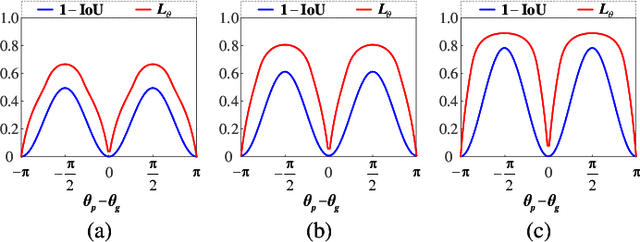Xiaoyu Dang
Category-Aware Dynamic Label Assignment with High-Quality Oriented Proposal
Jul 03, 2024



Abstract:Objects in aerial images are typically embedded in complex backgrounds and exhibit arbitrary orientations. When employing oriented bounding boxes (OBB) to represent arbitrary oriented objects, the periodicity of angles could lead to discontinuities in label regression values at the boundaries, inducing abrupt fluctuations in the loss function. To address this problem, an OBB representation based on the complex plane is introduced in the oriented detection framework, and a trigonometric loss function is proposed. Moreover, leveraging prior knowledge of complex background environments and significant differences in large objects in aerial images, a conformer RPN head is constructed to predict angle information. The proposed loss function and conformer RPN head jointly generate high-quality oriented proposals. A category-aware dynamic label assignment based on predicted category feedback is proposed to address the limitations of solely relying on IoU for proposal label assignment. This method makes negative sample selection more representative, ensuring consistency between classification and regression features. Experiments were conducted on four realistic oriented detection datasets, and the results demonstrate superior performance in oriented object detection with minimal parameter tuning and time costs. Specifically, mean average precision (mAP) scores of 82.02%, 71.99%, 69.87%, and 98.77% were achieved on the DOTA-v1.0, DOTA-v1.5, DIOR-R, and HRSC2016 datasets, respectively.
Joint User Association and Power Control for Cell-Free Massive MIMO
Jan 05, 2024Abstract:This work proposes novel approaches that jointly design user equipment (UE) association and power control (PC) in a downlink user-centric cell-free massive multiple-input multiple-output (CFmMIMO) network, where each UE is only served by a set of access points (APs) for reducing the fronthaul signalling and computational complexity. In order to maximize the sum spectral efficiency (SE) of the UEs, we formulate a mixed-integer nonconvex optimization problem under constraints on the per-AP transmit power, quality-of-service rate requirements, maximum fronthaul signalling load, and maximum number of UEs served by each AP. In order to solve the formulated problem efficiently, we propose two different schemes according to the different sizes of the CFmMIMO systems. For small-scale CFmMIMO systems, we present a successive convex approximation (SCA) method to obtain a stationary solution and also develop a learning-based method (JointCFNet) to reduce the computational complexity. For large-scale CFmMIMO systems, we propose a low-complexity suboptimal algorithm using accelerated projected gradient (APG) techniques. Numerical results show that our JointCFNet can yield similar performance and significantly decrease the run time compared with the SCA algorithm in small-scale systems. The presented APG approach is confirmed to run much faster than the SCA algorithm in the large-scale system while obtaining an SE performance close to that of the SCA approach. Moreover, the median sum SE of the APG method is up to about 2.8 fold higher than that of the heuristic baseline scheme.
 Add to Chrome
Add to Chrome Add to Firefox
Add to Firefox Add to Edge
Add to Edge